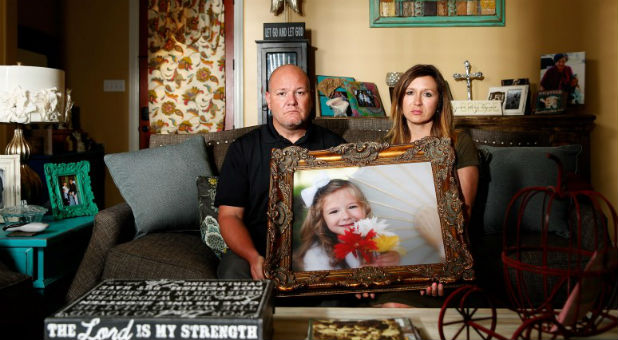Josiah Cooper-Pope, born 15 weeks premature, did fine in the neonatal intensive care unit for the first 10 days of his life.
Then, suddenly, his tiny body started to swell. Overnight, he grew so distended that his skin split.
His mother, Shala Bowser, said nurses at Chippenham Hospital in Richmond, Virginia, told her that Josiah had an infection and that she should prepare for the worst. On Sept. 2, 2010, she was allowed to hold him for the first and last time as he took his final breath. He was 17 days old.
What no one at the hospital told Bowser was that her newborn was the fourth baby in the neonatal unit to catch the same infection, methicillin-resistant Staphylococcus aureus, better-known as MRSA. It would sicken eight more, records show—nearly every baby in the unit—before the outbreak had run its course.
The shock of her son’s death came back to her when, after being contacted by Reuters earlier this year about the outbreak, Bowser went to Virginia’s Division of Vital Records to get a copy of Josiah’s death certificate. The cause of death: “Sepsis due to (or as a consequence of): Prematurity.” Sepsis is a complication of infection, but there was no mention of MRSA.
“My heart hurts,” Bowser said, sobbing. “I saw what this did to him. And then they just threw a bunch of words on the death certificate.”
According to their death certificates, Emma Grace Breaux died at age 3 from complications of the flu; Joshua Nahum died at age 27 from complications related to a skydiving accident; and Dan Greulich succumbed to cardiac arrhythmia at age 64 after a combined kidney and liver transplant.
In each case—and in others Reuters found—death resulted from a drug-resistant bacterial infection contracted while the patients were receiving hospital care, medical records show. Their death certificates omit any mention of the infections.
Fifteen years after the U.S. government declared antibiotic-resistant infections to be a grave threat to public health, a Reuters investigation has found that infection-related deaths are going uncounted, hindering the nation’s ability to fight a scourge that exacts a significant human and financial toll.
‘You Need to Know’
Even when recorded, tens of thousands of deaths from drug-resistant infections—as well as many more infections that sicken but don’t kill people—go uncounted because federal and state agencies are doing a poor job of tracking them. The Centers for Disease Control and Prevention (CDC), the go-to national public health monitor, and state health departments lack the political, legal and financial wherewithal to impose rigorous surveillance.
As a result, they miss people like Natalie Silva of El Paso, Texas, who contracted a MRSA (pronounced MER-suh) infection after giving birth. She died from infection-related complications nearly a year later, at age 23.
Silva’s sisters fought a successful battle to get the hospital to cite MRSA on her death certificate. Still, her death went uncounted: The Texas health department doesn’t track deaths like hers from antibiotic-resistant infections, and neither does the CDC.
As America learned in the battle against HIV/AIDS, beating back a dangerous infectious disease requires an accurate count that shows where and when infections and deaths are occurring and who is most at risk. Doing so allows public health agencies to quickly allocate money and manpower where they are needed. But the United States hasn’t taken the basic steps needed to track drug-resistant infections.
“You need to know how many people are dying of a disease,” said Ramanan Laxminarayan, director of the Center for Disease Dynamics, Economics & Policy, a Washington-based health policy research organization. “For better or worse, that’s an indicator of how serious it is.”
Drug-resistant infections are left off death certificates for several reasons. Doctors and other clinicians get little training in how to fill out the forms. Some don’t want to wait the several days it can take for laboratory confirmation of an infection. And an infection’s role in a patient’s death may be obscured by other serious medical conditions.
There’s also a powerful incentive not to mention a hospital-acquired infection: Counting deaths is tantamount to documenting your own failures. By acknowledging such infections, hospitals and medical professionals risk potentially costly legal liability, loss of insurance reimbursements and public-relations damage.
Doctors and other clinicians also may simply not understand the importance of recording the infections. Sandy Tarant, the doctor who signed Josiah Cooper-Pope’s death certificate, told Reuters that he thought “it didn’t matter” whether he cited a MRSA infection.
Legally, he’s right. Most states don’t require doctors to specify whether MRSA was a factor in a death. Washington and Illinois are exceptions.
State laws govern how death certificates are filled out. Most use a model law that mandates financial penalties for anyone who deliberately makes a false statement on the document, said Patricia Potrzebowski, director of the National Association for Public Health Statistics and Information Systems. The penalties are often small and rarely enforced, she said.
‘An Impressionist Painting’
Not even the CDC has a good handle on the extent of the problem. The agency estimates that about 23,000 people die each year from 17 types of antibiotic-resistant infections and that an additional 15,000 die from Clostridium difficile, a pathogen linked to long-term antibiotic use.
The numbers are regularly cited in news reports and scholarly papers, but they are mostly guesswork. Reuters analyzed the agency’s math and found that the estimates are based on few actual reported deaths from a drug-resistant infection.
The agency leaned heavily on small samplings of infections and deaths collected from no more than 10 states in a single year, 2011. Most didn’t include populous areas such as Florida, Texas, New York City and Southern California.
From those small samples, the CDC then extrapolated most of its national estimates, introducing so much statistical uncertainty into the numbers as to render them useless for the purposes of fighting a persistent public health crisis.
Describing the estimates to Reuters, even CDC officials used words like “jerry-rig,” “ballpark figure” and “a searchlight in the dark attempt.”
Michael Craig, the CDC’s senior adviser for antibiotic resistance coordination and strategy, said the agency, pressured by Congress and the media to produce “the big number,” settled on “an impressionist painting rather than something that is much more technical.”
In a statement emailed to Reuters, CDC officials said they released the 2013 estimates report “despite its limitations because of our profound concern about the seriousness of the threat.” The agency said it is working on improving its estimates.
The numbers of uncounted deaths from drug-resistant infections “speak to what can happen when we don’t allocate the necessary resources to bolster … our public health safety network,” said Senator Sherrod Brown. “When we see discrepancies in reporting, are unable to finance a workforce to monitor infections, and can’t even soundly estimate the number of Americans that die from [antibiotic-resistant infections] each year, we know we have a problem.”
The Ohio Democrat recently introduced a bill that would require the CDC to collect more and better data on superbug infections and death rates.
In the absence of a unified national surveillance system, the onus of monitoring drug-resistant infections and related deaths falls on the states. A Reuters survey of the health departments of all 50 states and the District of Columbia found wide variations in how they track seven leading “superbug” infections—if they do so at all.
Only 17 states require notification of C. difficile infections, for example, while just 26 states and Washington, D.C., do the same for MRSA. Fewer than half require notification of infections by carbapenem-resistant Enterobacteriaceae (CRE), a family of pathogens that the CDC has deemed an “urgent threat.” CRE gained notoriety when more than 200 people were sickened through contaminated medical scopes in hospitals from 2012 to 2015.
Twenty-four states and the District of Columbia—an area comprising 3 of every 5 Americans—said they do not regularly track deaths due to antibiotic-resistant infections. In contrast, all 50 states require reporting of deaths from AIDS. Deaths from hepatitis C and tuberculosis are also closely tracked.
‘Grossly Under-Reported’
States that said they do track deaths generally do so for only a few types of drug-resistant infections and not consistently. In the survey, they reported a combined total of about 3,300 deaths from 2003 to 2014.
That’s a tiny fraction of the actual toll: A Reuters analysis of death certificates found that nationwide, drug-resistant infections were mentioned as contributing to or causing the deaths of more than 180,000 people during the same period. To conduct the analysis, Reuters worked with the CDC’s National Center for Health Statistics’ Division of Vital Statistics to search text descriptions on death certificates to identify relevant deaths.
Among the states that don’t require reporting of superbugdeaths is California, the nation’s most populous state. The Reuters analysis identified more than 20,000 deaths linked to drug-resistant infections during the 12-year period, the most of any state. A health department spokeswoman said the state legislature authorized the department to be notified of infections, but not deaths.
Tennessee doesn’t require notification of deaths, either. The Reuters analysis found more than 5,500 deaths linked tosuperbugs there, more than half of them MRSA-related.
“We know we have a problem with MRSA in Tennessee,” said Marion Kainer, the state’s director of antimicrobial resistance programs. Requiring hospitals to report deaths is more than the department can take on right now, she said. “We have a significant problem getting clinicians to report just the disease,” she said. “It’s grossly under-reported.”
The totals from the Reuters analysis also indicate that the problem is getting worse nationwide, as the number of deaths from drug-resistant infections more than doubled from 8,600 in 2003 to about 16,700 in 2014. (Some of that increase could be the result of clinicians’ increased awareness of the infections.)
Death certificates aren’t a perfect measure. They can be wrong: Cause of death often is a judgment call by clinicians, who may blame a drug-resistant infection in error. More likely, they undercount drug-resistant deaths, as cases like that of Josiah Cooper-Pope show. Just how far under is impossible to know.
But there are clues: Connecticut, with a grant from the CDC, is the only state that closely monitors MRSA deaths. It logged 2,084 deaths from drug-resistant infections from 2003 to 2014, all but 10 from MRSA. That’s nearly twice the number of deaths from MRSA in the state that Reuters found in its death certificate analysis.
One reason for the disparity is that the state’s count includes anyone who died with MRSA, even if it wasn’t the cause of death, said Dr Matthew L. Cartter, Connecticut’s epidemiologist. He also said death certificates may undercount MRSA deaths because the physician may cite a general infection-related condition—death due to sepsis, for example—without mentioning the actual bacteria involved, or merely describe the mechanics of death, such as organ failure or cardiac arrest.
For many victims’ relatives interviewed by Reuters, the death certificate held special significance. They had watched an infection squeeze the life out of a loved one, often over several months and in gruesome ways. To find no official record of that on the death certificate came as a shock. It was as if the killer got away.
Misleading Death Certificates
Dan Greulich’s medical records show that, after his transplant operation, he spent five months battling drug-resistant infections that left him so debilitated he asked to be taken off of life support. He died in June 2012. By the time of his death—due to “cardiac arrhythmia,” according to the death certificate—the cost of his care at UCLA Medical Center amounted to more than $5 million.
“When the doctor wouldn’t count him as one of the people who die from hospital-acquired infections, I was outraged,” said Rae Greulich, his widow. She considered suing the hospital but never did.
UCLA Medical Center declined to comment.
Joshua Nahum’s recovery from a skydiving accident on Sept. 2, 2006, was going so well at Longmont United Hospital in Colorado that he was transferred to Northern Colorado Rehabilitation Hospital a month later in preparation for going home.
Within days, his temperature spiked, his condition deteriorated, and he was transferred back to Longmont. There, he was diagnosed with meningitis from Enterobacter aerogenes, a virulent drug-resistant pathogen spread almost exclusively in healthcare settings.
By the time he died on Oct. 22, the swelling in his brain had made him a quadriplegic, said his father, Armando Nahum. The infection was “the most immediate cause of his death,” his neurosurgeon, Dr E. Lee Nelson, told Reuters.
His death certificate said he died of “Delayed Complications of Craniocerebral Injuries” from the accident. “I remember being dumbfounded. ‘Are you serious?'” Nahum said. “All I asked was that they write the truth—that Josh died of an infection.”
Hospital records obtained by the family show he also contracted meningitis from a methicillin-resistant Staphylococcus epidermidis infection while at Longmont. Similar to MRSA, it is a potentially lethal drug-resistant bug.
In an email statement, Nancy Driscoll, chief nursing officer at Longmont United, said an independent review concluded that Nahum’s care “was appropriate.” She did not respond to questions about how he contracted the infections. Northern Colorado Chief Executive Officer Beth Bullard declined to discuss the case.
Because Nahum died nearly two months after the accident, the cause of death was certified by the Boulder County coroner’s office. Dr John E. Meyer, deputy coroner at the time, signed the death certificate. He told Reuters that he did not recall the case but would not have thought to specify that the complication was an infection.
“There’s certainly no rule that I know of,” he said.
Patient safety groups petitioned the CDC in 2011 to add a question about hospital-acquired infections to its standard death certificate, which is used by many states.
CDC Director Dr Thomas Frieden wrote that he would consider including patient advocates in discussions the next time the agency revises its death certificate, but there were no plans to make any changes “in the near future.”
In a statement emailed to Reuters, Frieden said: “While death certificates provide helpful information, the unfortunate reality is that they don’t provide in-depth clinical information.”
Protective Secrecy
Antibiotic-resistant bacteria have been around nearly as long as antibiotics. Alexander Fleming discovered penicillin, the first modern antibiotic, in 1928, saving millions of lives from infections that just a few years earlier would have been fatal. By 1940, researchers were reporting that bacteria had already developed resistance to the drug.
Modern science became locked in a war of one-upmanship with the microbial world. Researchers would develop a class of drugs to replace those that were becoming ineffective, and soon enough, bacteria would begin showing resistance to the new drugs—a problem worsened by widespread overprescription of antibiotics and their overuse in farm animals.
By the 1990s, drug-resistant infections had reached crisis proportions. Advances in medicine have been, paradoxically, a big reason for the worsening epidemic.
See an error in this article?
To contact us or to submit an article



















